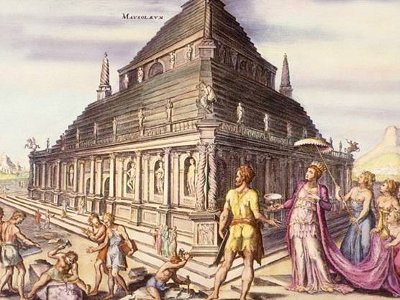The Mausoleum at Halicarnassus or also known as the Tomb Of Mausolus was a tomb built between 353 and 350 BCE at Halicarnassus for Mausolus,
a satrap in the Persian Empire, and Artemisia II of Caria, his wife and
sister

In 623 BCE, Halicarnassus was the capital of a small regional kingdom
in the coast of Asia Minor. In 377 BCE the ruler of the region,
Hecatomnus of Milas, died and left the control of the kingdom to his
son, Mausolus. Mausolus extended his territory as far as the southwest
coast of Anatolia and he and Artemisia ruled from Halicarnassus over the
surrounding territory for twenty-four years.
Mausolus chose Halicarnassus as a new capital that would be safe from
capture and magnificent in appearence. He had his workmen deepen the
city’s harbour and paved streets and squares on land. They also built
houses for ordinary citizens and on one side of the Harbour they built a
massive fortified palace for Mausolus positioned so as to have a clear
view out to sea and inland to the hills. In 353 BCE, Mausolus died and
his wife, broken-hearted, began the construction of the famous tomb so
beautiful that it became one of the Seven Wonders of The Ancient World. A
structure so famous, that Mausolus’ name is now the eponym for all
stately tombs, mausoleum.
Artemisia spared no expense in the building of the tomb. She sent for
the most talented artists of the time in Greece. The tomb itself was
erected on a hill overlooking the city and sat in an enclosed courtyard.
At the centre of the courtyard was a stone platform on which the tomb
sat. A stairway flanked by stone lions led to the top of the platform,
which bore along its outer walls many statues of gods and goddesses. At
each corner, stone warriors mounted on horseback guarded the tomb. The
marble tomb, positioned at the centre of the platform, one-third of the
Mausoleum’s height which measured 45m (148ft) in total. This section was
covered with low reliefs including famous tales like the battle of the
centaurs with the lapiths and Greeks in combat with the Amazons, a race
of warrior women. At the top of this section of the tomb thirty-six slim
columns, ten per side, with each corner sharing one column between two
sides; rose for another third of the height. Standing between each
pair of columns was a statue and behind the columns was a solid block
that carried the weight of the tombs massive roof. The roof which
comprised of the final third of the height was pyramidal and on top was
four massive horses pulling a chariot in which rode images of Mausolus
and Artemisia

The Mausoleum overlooked the city of Halicarnassus for many years. It
was untouched when the city fell to Alexander the Great in 334 BCE and
still undamaged after attacks by pirates in 62 and 58 BCE. It stood
above the city’s ruins for sixteen centuries. Then a series of
earthquakes shattered the columns and sent the bronze chariot crashing
to the ground. By 1404 CE only the very base of the Mausoleum was still
recognizable. Finally, what was left of the Mausoleum was briken down
and used to fortify the walls in around 1522 when Crusaders feared a
Turkish invasion.

خارج الموضوع تحويل الاكوادإخفاء الابتساماتإخفاء